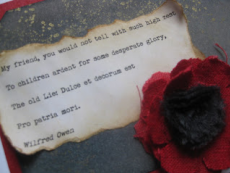
Email: ZYVC057@live.rhul.ac.uk
Total Article : 213
About Me:I'm a graduate student studying International Criminal Law and first started writing for King's News almost 4 years ago! My hobbies include reading, travelling and charity work. I cover many categories but my favourite articles to write are about mysteries of the ancient world, interesting places to visit, the Italian language and animals!

Dolce et decorum est was a popular saying during World War One, it means ‘it is sweet and righteous’ and was used to incite people to fight during the war. Wilfred Owen, one of the most prominent of war poets, is renowned for his shockingly grotesque description of the horrors caused by war. Having fought in combat and having witnessed the atrocities in first person, from the brutality of the trenches to the inhumanity of gas warfare, Wilfred Owen abandons the first wave of poets who– like Rupert Brooke – glorified war. Instead Owen seeks to show people the reality of war in all its shame through powerful descriptions and gripping scenarios.
The poem’s title, which is the old saying, makes the reader think that this will be a poem of incitation like many others yet Owen soon takes a more sinister approach to war. He begins by stripping soldiers of their labels of glory and describes them more like animals than humans. The soldiers are bent over like beggars carrying sacks and cough and curse as they stumble ahead until their commander tells them they are allowed to rest. Some of the men march asleep whilst others walk on with blood-shod feet as they have lost their boots. All of them are lame and blind, tired and deaf from all the shells falling behind them. Owen then describes a scene of a gas attack as all soldiers hurry to put their helmets on it time but one sadly doesn’t make it and the speaker sees him drowning. This is not the glorious death incited by Brooke but a tragic loss of life in the dehumanising environment of war. The speaker then sees the deceased man appear in his dreams, haunting him with the horrific vision he had to witness. If only we could follow the body as it was being taken away in a wagon, see his eyes roll and hear his voice gargling blood whenever the wagon would bounce then we would be more cautios with the famous saying. Whilst the title of the poem is ‘dolce et decorum est’, the entire Latin phrase – which is taken from an ode by Horace - is ‘dolce et decorum est pro patria mori’ which means ‘it is sweet and fitting to die for one’s country’. The object of the poem is to make the reader reflect upon such a common phrase and realise, like the speaker does, that it hides the true inhumanity of war.

DOLCE ET DECORUM EST (by Wilfred Owen)
Bent double, like old beggars under sacks,
Knock-kneed, coughing like hags, we cursed through sludge,
Till on the haunting flares we turned our backs,
And towards our distant rest began to trudge.
Men marched asleep. Many had lost their boots,
But limped on, blood-shod. All went lame; all blind;
Drunk with fatigue; deaf even to the hoots
Of gas-shells dropping softly behind.
Gas! GAS! Quick, boys!—An ecstasy of fumbling
Fitting the clumsy helmets just in time,
But someone still was yelling out and stumbling
And flound’ring like a man in fire or lime.—
Dim through the misty panes and thick green light,
As under a green sea, I saw him drowning.
In all my dreams before my helpless sight,
He plunges at me, guttering, choking, drowning.
If in some smothering dreams, you too could pace
Behind the wagon that we flung him in,
And watch the white eyes writhing in his face,
His hanging face, like a devil’s sick of sin;
If you could hear, at every jolt, the blood
Come gargling from the froth-corrupted lungs,
Obscene as cancer, bitter as the cud
Of vile, incurable sores on innocent tongues,—
My friend, you would not tell with such high zest
To children ardent for some desperate glory,
The old Lie: Dulce et decorum est
Pro patria mori.
Now that you have read the poem can you identify the rhyming pattern (if there is one) and the general structure of the poem? Give it a go!
Image 1: http://4.bp.blogspot.com/-_FdNGsgRthk/TrExvM5gVvI/AAAAAAAAAWI/M7fJpH_Y_tI/s320/IMG_1044.JPG
Image 2: http://e08595.medialib.glogster.com/media/95/959ae00f36abf21d663392869ca2204f7d986ae63827b02d30de5fd2eaad895c/21062.jpg

0 Comment:
Be the first one to comment on this article.